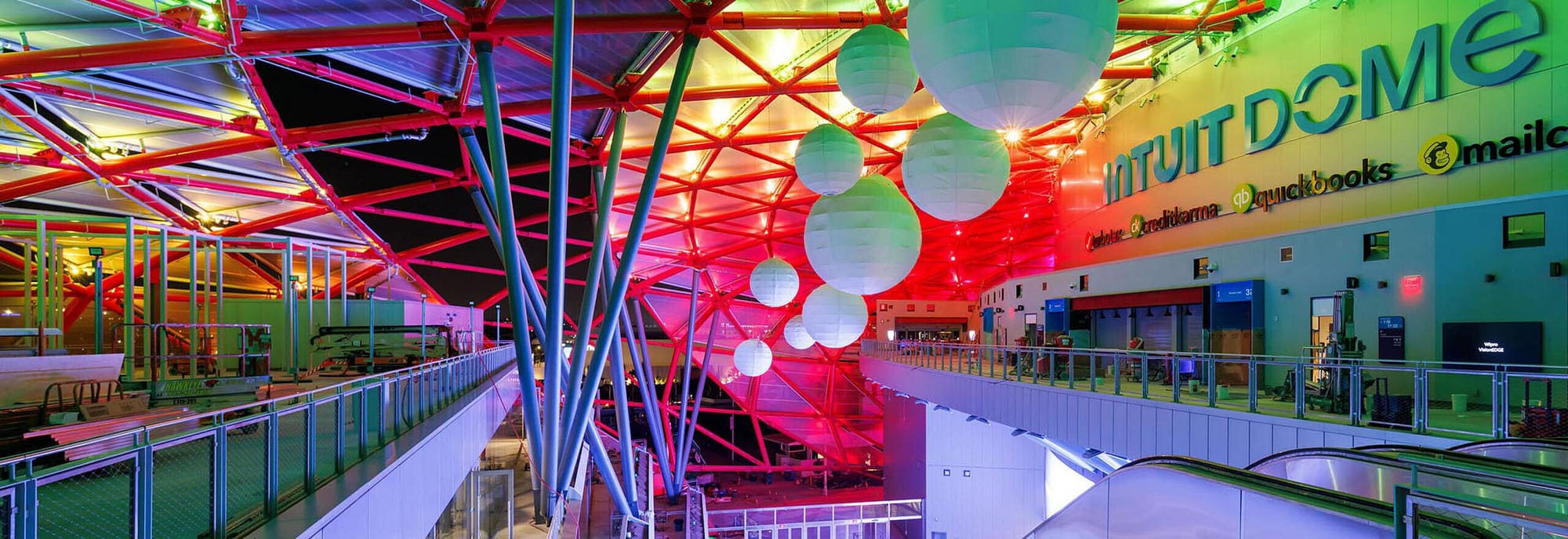INTUIT DOME ART PREVIEW
Intuit Dome
Inglewood
We made long, slow shadows, watched them bleed into the pallid concrete. For what felt like an hour, we’d be waiting for “Jenna.” Only she, I was told, could get me to my car.
It was late afternoon, early August. Intuit Dome, the new Westside arena, still had weeks until its christening by Bruno Mars, but we were there for the unveiling of its art. For reasons I was now finding hard to remember, this had seemed like a funny thing to go to.
The folly of the plan — if you can call it that — started to creep over me even on the drive there. How petty, this taste for banality, which I try to pass off as perverse. Is time so cheap that I should schlep across town in rush hour traffic just to lob some harmless jokes at public art clumsily prettifying gentrification? The 10 makes everything seem small.
Steve Ballmer built Intuit Dome at a cost of two billion dollars to be the home of the Los Angeles Clippers, which he bought 10 years ago, also for two billion dollars. Ballmer is the former CEO of Microsoft, currently the seventh-richest person in the world. You wouldn’t know it from the snack table. “These cookies are appalling,” I said to a guy with a camera hanging from his neck. He was circumspect. “Maybe they are,” he said. He was from a local Inglewood news site, and I asked him if the people of Inglewood were angry about Intuit Dome, and about SoFi Stadium, a mile to the north, with its vast adjoining retail and residential complex, driving up rents and so forth. “Some,” he said. “But here it is.” Which I couldn’t exactly argue with.
“Here it is” was also the gist of what happened next. An Intuit Dome representative got up and told us about Intuit Dome’s commitment to art and to the neighborhood, which is why they put all this art outside, where everyone can see it. They had commissioned a handful of L.A. artists to beautify the street and the promenade leading to the arena’s entrance. We toured the works and listened to the artists explain their inspirations and intentions. Facing Prairie Avenue was a vast, colorful mural in enamel by Michael Massenburg, an Inglewood local, depicting people playing music and playing sports and dancing. It was called Cultural Playground, which felt like an apt title for a lot of the stuff. Refik Anadol, who uses AI to translate datasets into gurgling digital colorways, explained that the shapes and colors we were seeing on this big screen on the side of the building came from weather patterns and basketball stats. Glenn Kaino made a sculpture of a clipper ship, its mast rendered in an arrangement of backboards and hoops. Kaino is known for making art that addresses issues of social justice; the context required messages of positivity and unity: “Lead with love,” it said on one of the backboards. “We may have all come on different ships but we’re in the same boat now” said a pink neon sign by Patrick Martinez.
Some excellent art has been made about (or through) basketball — by David Hammons or Paul Pfeiffer — but even if they’d gotten one of them over here, it would probably still be bad. Intuit Dome is an impossible context, for reasons that became clear when I saw the painter Jonas Wood. He was commissioned to design a jersey for the Clippers, which makes sense because he is well known for his love of basketball, a recurring subject in his work. It’s also funny because he is well known for his love of a different team, the Boston Celtics. The Clippers have no fans to speak of. They are a miserable, cursed franchise. They floundered in mediocrity for decades under the famously cheap ownership of slumlord Donald Sterling, who was finally forced to sell the team after he was caught on tape saying racist things about Magic Johnson. Since Ballmer bought the team, they’ve spent fantastic amounts of money and traded away all their draft picks to get star players and still they’re mediocre, and still no one loves them, and they never will. Some things, Steve, you can’t buy.
With these cheering thoughts, I set off for the parking lot. I wandered lonely, and I doubled back, became confused, and then angry. I spoke with several Intuit Dome employees, and after some discussion, it was concluded that I must have parked in the loading dock, now completely inaccessible to me, they said, because it was down corridors and special-permit elevators. I’d have to wait for an escort. I protested. They passed me off to James, a white guy with a pointy goatee, who would have taken me himself but he couldn’t leave his post. It was unclear what that was, but I came to think of him as my jailer. It was hours, I’m sure. We studied the shadows we cast on the ground with greater scrutiny than I’d paid any of the day’s art. I asked him how long he’d worked at Intuit Dome, and he said just a couple weeks, that they’d only done maybe one or two events before this one. I asked him if he liked it, and he said he liked it fine, but it wasn’t very consistent work and he wished he could get more hours.






